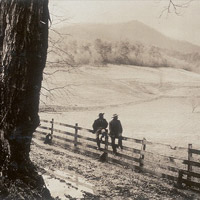 |

北卡羅來那州切諾基地區的一個印第安人保留區 (1909)

|
 |
|
 |
1790年10月3日出生的小約翰酋長 (Chief
little John) 與淚水小徑 (Trail
of Tears)
約翰‧羅斯生於1790年10月3日。他的切諾基名是Tsan-Usdi,意思就是「小約翰」。他長大之後成為了切諾基團結聯盟 (United
Cherokee Nation) 的領袖。
約翰‧羅斯和許多切諾基人都拒絕接受強迫他們遠離家鄉的「1830年印第安人遷徙法」 (1830
Indian Removal Act) 。羅斯代表他的人民多次到華盛頓進行談判,他甚至還成功的向最高法院提出告訴。雖然最高法院最後的判決對切諾基人有利,但是傑克生 (Andrew
Jackson) 總統卻拒絕派遣部隊到保護居留地裡的美國印第安原住民。
要帶領自己的人民跋涉到奧克拉荷馬州這樣陌生的地方,或許就是約翰‧羅斯做過最令自己難過的事情。如果你被迫要永遠離開家鄉,你會有什麼感觸呢?
John Ross was born on October 3, 1790. His Cherokee name was Tsan-Usdi, which means Little John. When he grew up, he became Chief of the United Cherokee Nation.
John Ross and many Cherokee tried to resist the 1830 Indian Removal Act that forced them from their land. Ross made repeated trips to Washington as representative of his people, and he even successfully argued the tribe's case before the Supreme Court. The Supreme Court ruled in favor of the Cherokee people, but President Andrew Jackson refused to send troops to protect the American Indians on their homeland.
Leading his people to the unfamiliar territory of Oklahoma may have been the
saddest thing John Ross ever had to do. How would you feel if you were
forced to leave your home forever?

  2/2 頁 2/2 頁

|





